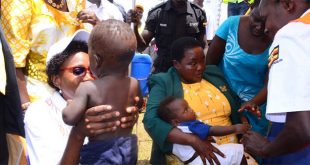
Late antenatal care and treatment defaults among pregnant women are a major concern.
Kampala, Uganda | PATRICIA AKANKWATSA | Uganda has made major strides in reducing the number of infants born with HIV, but persistent challenges remain in achieving the goal of zero infections. While the country has implemented effective prevention strategies and expanded access to antiretroviral therapy (ART), the number of new HIV infections among children continues to be higher than expected.
According to the Uganda AIDS Commission (UAC), the number of babies born with HIV has decreased from over 8,000 in 2016 to 4,700 by December 2023.
However, the UAC remains concerned about the ongoing transmission of HIV from mothers to their babies, primarily due to late antenatal care and poor adherence to treatment regimens. Despite the availability of effective prevention tools, many women do not seek healthcare early enough for timely interventions.
Speaking to the media on October 23rd at the Uganda media center, Dr. Vincent Bagambe, the Director of Planning and Strategic Information at UAC, said that Uganda’s target of reducing mother-to-child transmission (MTCT) to 3,000 cases or fewer per year by 2025 is at risk.
While the country has implemented a comprehensive PMTCT program, including early antenatal care, antiretroviral therapy, and infant testing, challenges such as late care and treatment adherence continue to hinder progress.
The PMTCT program has successfully enrolled 98% of pregnant women living with HIV on treatment, but a significant number of infants are still being infected. Studies by the Uganda AIDS Commission have revealed that some women acquire HIV during pregnancy and delay seeking antenatal care, increasing the risk of transmission. Additionally, many mothers on HIV treatment default on their medication, leading to higher viral loads and increased transmission risk.
“While we have made significant progress, we are not where we need to be. Mothers go late for antenatal care and it is hard to prevent the transmission especially if the mother just acquired HIV,”
The UNAIDS 2021 Spectrum estimates indicate there were over 4000 new childhood HIV infections in Uganda due to mother-to-child transmission. Half of those infections occurred among infants born to mothers who stopped HIV treatment during pregnancy and breastfeeding. According to the 2018–2023 Ugandan National Elimination Plan II, mother-to-child transmission of HIV accounts for 18% of all new infections in Uganda. It is also the primary source of infections among children.
To improve, the management of mother-to-child transmission (MTCT) of HIV Uganda introduced the Point-of-Care HIV viral load test in 2022.
Before the implementation of the Point-of-Care test, the prolonged turnaround time for HIV viral load testing presented a significant challenge in ensuring timely and effective treatment for women living with HIV. By reducing turnaround times from one month to 48 hours, the Point-of-Care test has enabled healthcare providers to make more informed decisions regarding treatment adjustments.
“We have the technology and resources to eliminate mother-to-child transmission of HIV, but we must address the challenge of treatment adherence,” Dr Bagambe added.
“For a woman living with HIV, achieving viral load suppression through effective HIV treatment virtually eliminates the possibility of transmitting HIV to her child,”
“Every missed dose of antiretroviral medication puts a pregnant woman at risk of transmitting HIV to her baby. Consistent treatment is essential for protecting the health of both mother and child,”
Dr. Bagambe also expressed concern about the deteriorating sexual behavior among young people, with fewer individuals using condoms and seeking HIV testing. A study by the Uganda AIDS Commission found that only 10% of women reported using a condom during their last sexual encounter with a non-partner.
“Of the 38,000 new HIV infections recorded in 2023, 20,000 occurred among women, with 15,000 of those cases affecting adolescent girls and young women,”
A recent UNAIDS report highlighted that many countries, including Uganda, are falling short of achieving the goal of ending AIDS by 2030. In sub-Saharan Africa, women and girls account for 62% of all new HIV infections, with over 400,000 adolescent girls and young women becoming infected globally each week.
According to Jacqueline Makokha, the UNAIDS gender inequality is a major driver of the HIV epidemic, particularly among women and girls in sub-Saharan Africa.
“Gender inequality can manifest in various forms, including limited access to education, economic opportunities, and healthcare services. These disparities can contribute to women’s vulnerability to HIV by restricting their ability to make informed decisions about their sexual health, negotiate safer sex practices, and access prevention and treatment services,”
In sub-Saharan Africa, approximately 30,100 new HIV infections occur among adolescent girls and young women aged 15-24 each year.
 The Independent Uganda: You get the Truth we Pay the Price
The Independent Uganda: You get the Truth we Pay the Price



